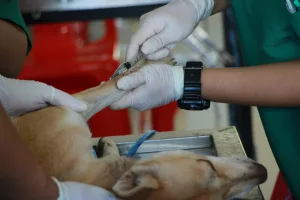Have you ever wondered why dogs wag their tails? This seemingly simple behavior actually plays a crucial role in canine communication. When a dog wags its tail, it is not just a sign of happiness, but a complex form of non-verbal communication. The Tail as a Communication Tool When a dog wags its tail, it is using it as a communication tool to convey its emotions and intentions to other dogs and humans. The direction and speed of the tail wag can indicate different meanings. For example, a wagging tail held high and wagging rapidly may signal excitement or happiness, while a low, slow wag may indicate insecurity or fear. Dogs have evolved to use their tails as a way to express themselves in a nuanced manner, making it an essential part of understanding their behavior.
Understanding Tail Wagging Directions
Did you know that the direction of a tail wag can also communicate different messages? Research has shown that dogs often wag their tails to the right when they experience positive emotions and to the left when they encounter something negative or unfamiliar. For instance, a dog seeing its owner might wag its tail predominantly to the right, while encountering a stranger might cause a wag to the left. This asymmetrical tail wagging is part of a dog’s sophisticated communication toolkit.
Tail Wagging and Social Hierarchies
In canine social structures, tail wagging can also reflect social hierarchies. A dominant dog might hold its tail high and wag it slowly, signifying confidence and authority. Conversely, a submissive dog may lower its tail and wag it quickly, indicating submission or appeasement. Understanding these nuances can be particularly helpful when introducing dogs to each other, ensuring a harmonious interaction.
Emotional Expression
Tail wagging is a form of emotional expression for dogs. It is their way of expressing joy, excitement, fear, or even aggression. The position of the tail, along with the wagging motion, can give insight into the dog’s emotional state. Dogs are masters of body language, and the tail is just one of the many ways they communicate with us. Understanding the different nuances of tail wagging can help pet owners better interpret and respond to their dogs’ feelings and needs.
Recognizing Aggression Through Tail Wagging
While many people interpret a wagging tail as a sign of friendliness, it can sometimes indicate aggression. A stiff, rapid wag with the tail held high may signal an aggressive or confrontational stance. It’s crucial to observe other body signals in conjunction with the tail, such as bared teeth, a tense body, or a wrinkled nose, to accurately assess the dog’s mood.
The Happy Tail Syndrome
Interestingly, there’s a condition known as “Happy Tail Syndrome,” where dogs wag their tails with such enthusiasm that they can injure themselves by hitting their tails against hard objects. This is most common in large, energetic breeds. If your dog is prone to this, consider providing a space with soft surfaces or using protective coverings to prevent injuries.
Chemical Communication
In addition to visual cues, dogs also use their tails to spread their scent. The base of a dog’s tail contains scent glands that release pheromones, which can communicate information about the dog’s gender, reproductive status, and even its emotional state. So, when a dog wags its tail, it is not only signaling its emotions but also leaving behind a chemical message. This chemical communication is an intricate aspect of canine social interaction, allowing dogs to convey complex information beyond what is visible to the naked eye.
The Role of Pheromones in Social Interactions
Pheromones play a significant role in how dogs interact with one another. When a dog wags its tail, it helps disperse these chemical signals, which other dogs can detect and interpret. This is why dogs often sniff each other’s rear ends when they meet—it’s a way to gather information. As a dog owner, understanding this behavior can help you manage introductions between dogs more effectively.
Context Matters
It’s important to consider the context in which a dog is wagging its tail. A wagging tail does not always mean a dog is happy or friendly. A dog may wag its tail while feeling anxious, threatened, or even aggressive. Understanding the overall body language of a dog, along with the tail wagging behavior, is crucial for interpreting their true intentions. By observing the tail wagging in conjunction with other body signals, such as ear position and facial expressions, pet owners can gain a more comprehensive understanding of their dog’s emotional state.
Reading the Whole Picture
To truly understand what a dog is communicating, it’s essential to consider the tail wag in the context of the entire body language. Ears pinned back, eyes wide, and a tense body may indicate fear or stress, even if the tail is wagging. Conversely, a relaxed body, soft eyes, and a loosely wagging tail are clear signs of a happy, content dog.
Practical Tips for Dog Owners
- Observe Closely: Pay attention to your dog’s entire body language, not just the tail. This will help you accurately interpret their feelings and respond appropriately.
- Socialization: Regular, positive experiences with other dogs and people can help your dog develop a healthy communication style, reducing instances of misinterpretation.
- Training and Familiarity: Training your dog to understand and respond to basic commands can help manage their behavior in social situations, making it easier to interpret their tail wagging.
Tail Docking and Its Impact
Tail docking, the practice of removing part of a dog’s tail for cosmetic reasons, can significantly impact a dog’s ability to communicate. This practice is controversial and can hinder a dog’s natural communication abilities, leading to misunderstandings with other dogs and people. If you’re considering tail docking, it’s important to weigh the implications for your dog’s social and emotional well-being.
Alternatives to Tail Docking
For breeds where tail docking is common, consider alternatives that preserve the dog’s natural communication tools. Many organizations advocate for leaving tails intact, as it allows dogs to express themselves fully and engage in healthy social interactions.
Common Misunderstandings
- All Wags Are Not Equal: Not all tail wags are signs of happiness. Educating yourself about the various meanings can prevent misunderstandings and potential conflicts.
- Cultural Differences: Just as different human cultures have unique communication styles, different dog breeds may have variations in their tail wagging behaviors. It’s essential to know your dog’s breed characteristics and tendencies.
The Importance of Training and Education
Dog owners can benefit greatly from training and education on canine behavior. Understanding what tail wagging signifies is just one aspect of responsible dog ownership. Enrolling in a dog training class or consulting with a professional can provide valuable insights and skills for interpreting and responding to your dog’s communication cues.
Advanced Research and Studies
For further reading on this fascinating topic, consider looking into studies by researchers like Dr. Patricia McConnell and Dr. Stanley Coren, who have delved into the science of canine behavior and communication. Their research provides valuable insights into the intricate world of dog communication and can help deepen your understanding of how dogs use their tails to express themselves.
Future Directions in Canine Communication Research
The field of canine communication is continually evolving, with new technologies and methodologies providing deeper insights. Future research may explore the genetic basis of tail wagging, the impact of environmental factors on communication, and the development of more advanced tools for interpreting canine signals.
By broadening our understanding of these complex behaviors, we can foster better relationships with our canine companions, ensuring that their needs are met and their expressions are accurately interpreted. This journey into the world of dogs is not just about understanding them better, but also about improving the quality of life for both dogs and their human families.



